

Les Oyas. « Oyas », un système d'arrosage ancestral remis au goût du jour à Gignac. C'est l'histoire d'une belle aventure socio-écologique.
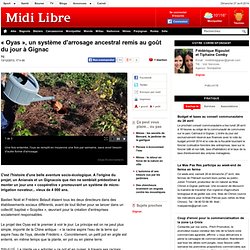
A l'origine du projet, un Anianais et un Gignacois que rien ne semblait prédestiner à monter un jour une « coopérative » promouvant un système de micro-irrigation novateur... vieux de 4 000 ans. Bastien Noël et Frédéric Bidault étaient tous les deux directeurs dans des établissements sociaux différents, avant de tout lâcher pour se lancer dans un collectif, baptisé « Scopitex », œuvrant pour la création d'entreprises socialement responsables. Le projet des Oyas est le premier à voir le jour.
Le principe est on ne peut plus simple, importé de la Chine antique : « la racine aspire l'eau de la terre qui aspire l'eau de l'oya, dévoile Frédéric ». Concrètement, un petit pot en argile est enterré, en même temps que la plante, en pot ou en pleine terre. Olla Watering - Ancient Drip Irrigation. The Olla (pronounced (Oy-ya) irrigation system is an ancient practice, and very simple in concept.
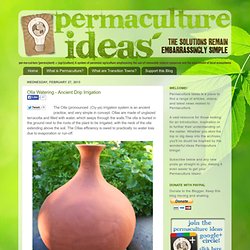
Ollas are made of unglazed terracotta and filled with water, which seeps through the walls.The olla is buried in the ground next to the roots of the plant to be irrigated, with the neck of the olla extending above the soil. The Ollas efficiency is owed to practically no water loss due to evaporation or run-off. This system can be applied to almost any type of garden, although plants with woody root systems may damage the pot. If you're quite adept at the clay wheel, they seem to be a pretty basic project, or perhaps there's a terracotta pot store near you where you can either order one or fashion one out of something they sell. Fichier:Bottle irrigation.jpg. Le petite irrigation dans le zones arides - Critères et options pour des méthodes d'irrigation appropriées. Le développement des techniques d'irrigation modernes doit avoir pour objectif d'utiliser au mieux l'eau, en même temps que les terres, les ressources humaines et les autres intrants essentiels (énergie, machines, engrais et lutte phytosanitaire) de façon à renforcer durablement la production agricole.
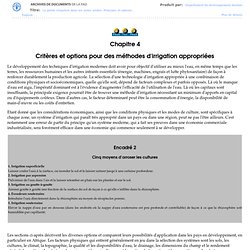
La petite irrigation dans les zones arides: principes et options - Hillel, D. Micro Oasis - Global Social Venture Competition (GSVC) Finalist 2012. Porous Clay Capsule Irrigation. Simple Olla Irrigation Clay vessels or pots made from low fire terra cotta clay are porous enough to allow water to pass through them when buried in soil.
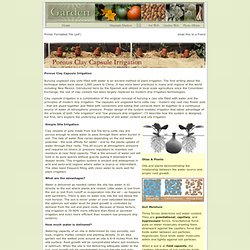
The rate of water flow varies depending on the soil water potential - the soils affinity for water - and by the plants uptake of water through their roots. This all occurs at atmospheric pressure and requires no timers or pressure regulators to maintain soil moisture at near field capacity. That is the amount of water soil will hold in its pore spaces without gravity pulling it downward to deeper levels. Micro Oasis. MICRO OASIS: An Integrated Solution for Dry Land Farming Micro Oasis enables Indonesian dry land farmers cultivate their land during the long dry seasons (8-9 months) to improve their livelihood, health & education, and water sustainability.
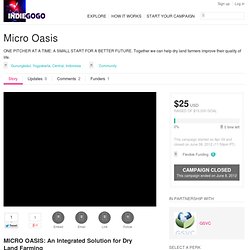
Our integrated solution includes Pitcher Fertigation System (PFS), water procurement, and farming education. With that, we can help Indonesian dry land farmers escape from the circle of poverty (video). We have raised $10,000 as we won the Global Social Venture Competition - South East Asia for the Best Business Plan and Social Impact Assessment. We hope to raise $25,000 by winning the Global GSVC to cover water procurement costs (well drilling, water pump, water towers). Your Donation is DIRECT!
All of your donation will be used for PFS procurement (pitchers, pipes/hoses, mariotte tubes). Each of your $5 represents 1 pitcher (clay pot + inclusive of PFS component costs) to the farmers. 08chapter7. Irrigation en climat sec. Retour en grace d'un vieux savoir traditionnel, une fois n'est pas coutume.. Ce qui suit est un condensé de 2, 3 articles sur le sujet (#1), en Anglais, ce système me semblant avoir énormément d'intéret, en particulier pour le pourtour méditérannéen, dont je suis. Pratiques Humaines en Zone Semi Aride. Suite à ses balades dans le désert qui lui ressemble, dans le silence, il avait besoin de définir son humanité.
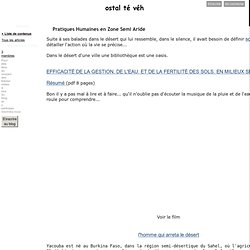
Global Buckets: Olla Irrigation. We've been inspired by Fan Sheng-chih Shu.
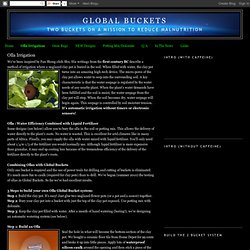
His writings from the first century BC describe a method of irrigation where a unglazed clay pot is buried in the soil. When filled with water, the clay pot turns into an amazing high-tech device. The micro-pores of the clay pot allows water to seep into the surrounding soil. A key characteristic is that the water seepage is regulated by the water needs of any nearby plant. Olla : Water Efficiency Combined with Liquid Fertilizer Some designs (see below) allow you to bury the olla in the soil or potting mix. Combining Ollas with Global Buckets Only one bucket is required and the use of power tools for drilling and cutting of buckets is eliminated. Ollas: Unglazed Clay Pots for Garden Irrigation Permaculture Research Institute.
A Sri Lankan villager fills his olla Photo copyright © Craig Mackintosh I first encountered the concept of using unglazed clay vessels for sub-surface irrigation in Bill Mollison’s “The Global Gardener” film series.
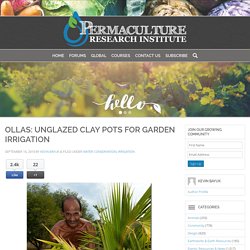
Mollison comments that the technique might be, to paraphrase, “the most efficient irrigation system in the world.” More recently I noted with interest that the fine folks at Path to Freedom were employing these clay pots for some of their raised beds, which led me to wonder about how I might experiment with them as a potential sub-surface irrigation system. How to Use the Porous Clay Pots and Pipes System - Howtopedia. From Howtopedia - english Porous clay pots and pipes are a means of water application that conserve water by applying water directly to the roots of plants, thereby limiting evaporation losses Short Description Problem:Idea:Porous clay pots and pipes conserve water and enable crops to grow in areas where they otherwise could not grow.
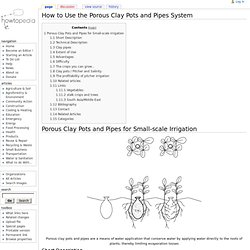
With this technology, it becomes possible to save water and irrigate small vegetable gardens in rural areas. Difficulty:The initial labour required to manufacture the pots/pipes and install this technology is very high. Technical Description.